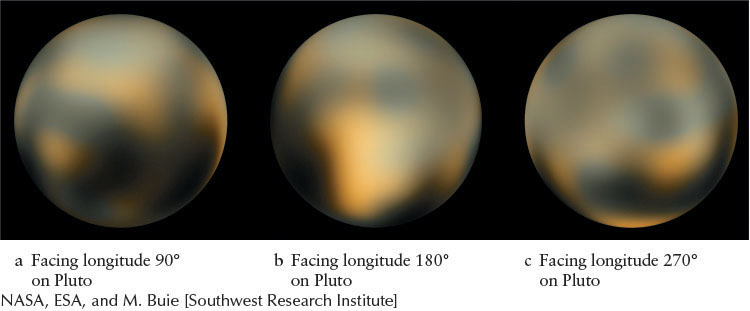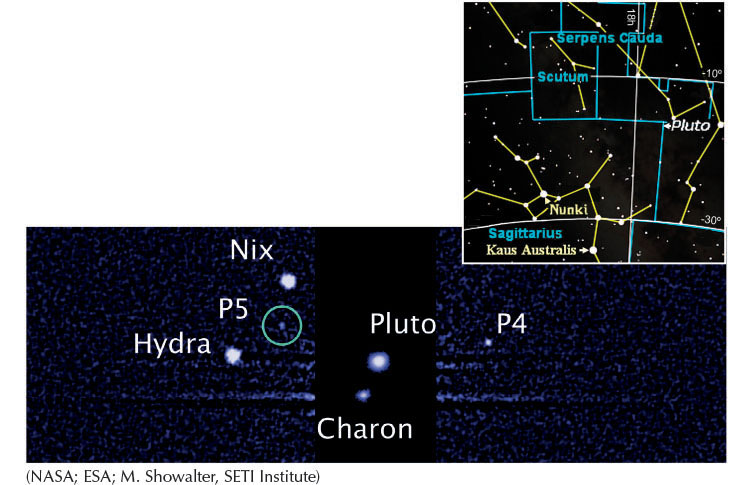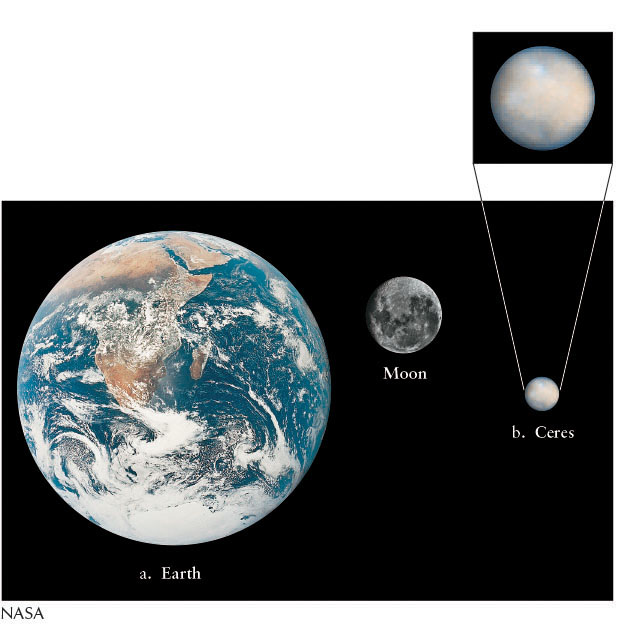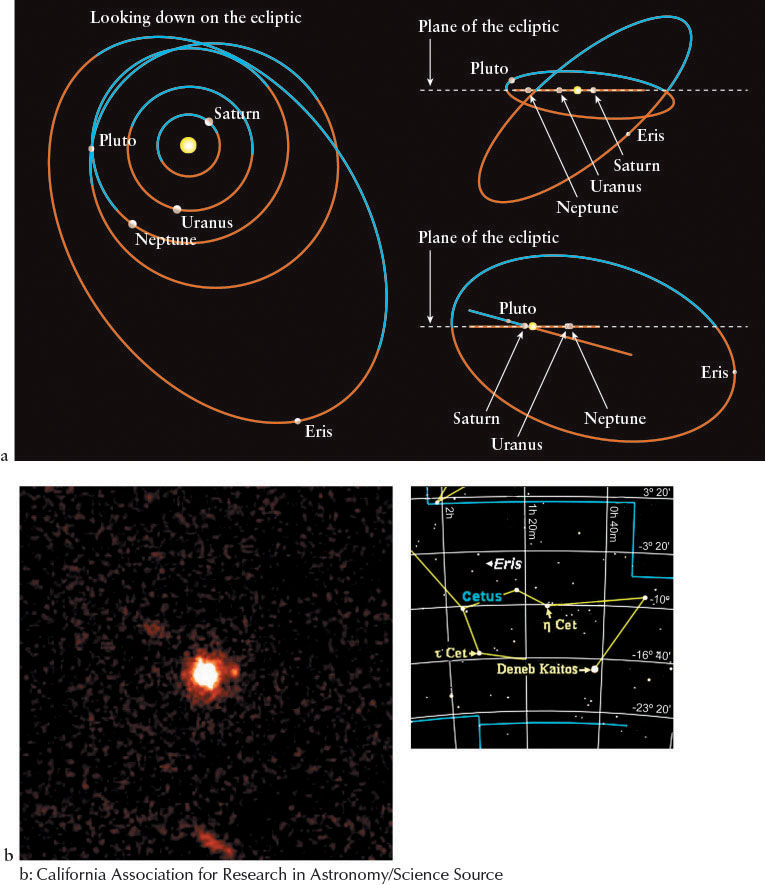Dwarf Planets
9-1 Pluto and its moon, Charon, are about the same size
Pluto (Figure 9-1) was discovered in 1930 by Clyde Tombaugh (1906–1997), who found it by examining photographic plates showing that it moved among the background stars from night to night (Figure 9-2). Allowing for our improved technology using computers and CCDs to take the images, this discovery technique is still standard for finding other dwarf planets and small solar system bodies.


Unlike the planets, Pluto’s orbital eccentricity of e = 0.25 (see Section 2-5) is so great that it is sometimes closer to the Sun than Neptune, as it was from 1979 to 1999. Pluto is now farther away from the Sun than Neptune and will continue to be so until April 5, 2231 (Figure 9-3). Pluto’s orbital inclination, the tilt of its orbit with respect to the plane of the ecliptic, is just over 17o, far greater than that of any planet (Figure 9-3c).

277
Little was known about Pluto for half a century until astronomers noticed that its image sometimes appears oblong (Figure 9-4). This observation led to the discovery in 1978 of Pluto’s largest moon, Charon (pronounced KER-en, after the mythical boatman who ferried souls across the River Styx to Hades, the domain ruled by the Roman god Pluto). The mass of an object in space can only be determined directly from its gravitational attraction on another body. We know the mass of the Sun because we can determine the length of Earth’s year. We know the mass of Mars because we can determine the periods of its moons Phobos and Deimos. The mass of Pluto, 2.2 × 10−3 M⊕, was not known until the orbit of Charon was accurately determined in the early 1980s.

 RIVUXG Discovery of Charon Long ignored as just a defect in the photographic emulsion, the bump on the upper left of this image of Pluto led astronomer James Christy to discover the moon Charon.
RIVUXG Discovery of Charon Long ignored as just a defect in the photographic emulsion, the bump on the upper left of this image of Pluto led astronomer James Christy to discover the moon Charon.
From 1985 through 1990, the orbit of Charon was oriented so that Earth-based observers could watch it eclipse Pluto. Astronomers used observations of these eclipses to determine that Pluto is only twice as wide as its satellite: Pluto’s diameter is 2380 km and Charon’s is 1190 km. Their similarity in size has led to a debate as to whether they should be classified as a binary dwarf-planet system.
278
The average distance between Charon and Pluto is less than one-twentieth the distance between Earth and our Moon. Furthermore, both bodies always keep the same side facing each other. That is to say, they both have synchronous rotation with respect to each other. As seen from the satellite-facing side of Pluto, Charon neither rises nor sets, but instead hovers in the sky, perpetually suspended in the same place above the horizon.
The exceptional similarities between Pluto and Charon suggest that this binary system may have formed when Pluto collided with a body of similar size. Perhaps chunks of matter were stripped from this second body, leaving behind a mass, now called Charon, vulnerable to capture by Pluto’s gravity. Alternatively, perhaps Pluto’s gravity captured Charon into orbit during a close encounter between the two worlds. For either of these two scenarios to be feasible, many Pluto-sized objects must have existed in the outer regions of the young solar system. One astronomer estimates that there had to be at least a thousand Pluto-sized bodies for a collision or close encounter between two of them to have occurred at least once since the solar system formed 4.6 billion years ago.
In 2005, the Hubble Space Telescope detected two other moons orbiting Pluto (Figure 9-5). Called Nix (named after the goddess of the night and mother of Charon) and Hydra (named after the nine-headed serpent living at the gates of Hades), these moons are both much smaller than Charon. The fourth and fifth known moons, temporarily labeled P4 and P5, were discovered in 2011 and 2012, respectively.

 RIVUXG Pluto and Its Five Known Moons Observations by the Hubble Space Telescope in 2005 revealed two intermediate-sized moons, each about 5000 times dimmer than Pluto. Named Nix and Hydra, they are each about 75 km (50 mi) across and between 2 and 3 times farther from Pluto than its moon Charon. P4 and P5 are each about 25 km (15 mi) in diameter.
RIVUXG Pluto and Its Five Known Moons Observations by the Hubble Space Telescope in 2005 revealed two intermediate-sized moons, each about 5000 times dimmer than Pluto. Named Nix and Hydra, they are each about 75 km (50 mi) across and between 2 and 3 times farther from Pluto than its moon Charon. P4 and P5 are each about 25 km (15 mi) in diameter.
Like Neptune’s moon Triton, Pluto and Charon are probably both composed of nearly equal amounts of rock and ice. The surface of Pluto (see Figure 9-1) has 12 distinct regions—more large-scale features than any object in the solar system other than Earth. Such features on Earth include oceans and continents, while on Pluto they are likely to include regions dominated by rock, regions dominated by ice, major impact regions, and mountain ranges. It is too early to say anything about the physical properties of Nix, Hydra, P4, or P5.
Studies of Pluto’s surface show that different regions vary in temperature from one another by up to 25 K. Furthermore, its surface features are changing in color and brightness, possibly as a result of seasonal effects. Specifically, it is getting redder and its northern hemisphere is getting brighter. Its spectrum shows that its surface contains frozen nitrogen, methane, and carbon monoxide. The orange tinge may be due to the presence of carbon-rich compounds on its surface, the result of methane there being chemically altered by the Sun’s ultraviolet radiation. The brightest regions are believed to be covered with frozen carbon monoxide, while the darker regions probably contain rocky debris. The dwarf planet is also observed to have a very thin atmosphere of nitrogen and carbon monoxide. In contrast, Charon’s surface appears to be covered predominantly with water ice. So intriguing, unusual, and unexplored are Pluto and its companions that NASA launched the New Horizons spacecraft in 2006 to visit them (scheduled to arrive there in July 2015) and then to continue deeper into the Kuiper belt. Kuiper belt objects (KBOs) were introduced in Section 5-5.
279
9-2 Ceres is a dwarf planet in the asteroid belt, while Pluto, Eris, Haumea, and Makemake are trans-Neptunian objects as well as dwarf planets
On New Year’s Day 1801, the Sicilian astronomer Giuseppe Piazzi (1746–1826) was carefully mapping faint stars in the constellation Taurus. He noticed a dim, previously uncharted “star” that shifted its position slightly over the next several nights. Uranus had been discovered in this way by William Herschel just 20 years before. Later that year, the orbit of Piazzi’s object was determined to lie between Mars and Jupiter. At his request, it was named Ceres (pronounced See-reez), after the patron goddess of Sicily. Based on erroneous observations of its size, Ceres was initially catalogued as a planet. In 1855, further observations revealed that all of the then-known planets—Mercury, Venus, Earth, Mars, Jupiter, Saturn, and Uranus—were much larger than Ceres. We now know that Piazzi was the first astronomer to discover an asteroid.
Ceres is spherical like the planets (Figure 9-6), but its diameter is a scant 940 km (585 mi), only one-quarter the diameter of our Moon. In 2006, Ceres was classified as a dwarf planet. Recent calculations suggest that, like the planets, Ceres is differentiated, containing a rocky core and clad in an icy outer layer.

Eris was first observed in 2003, before the present definitions of planets, dwarf planets, and SSSBs were established. This body is presently located 97 AU from the Sun, 3 times farther out than Pluto. All bodies orbiting the Sun beyond Neptune are called trans-Neptunian objects or TNOs. Pluto, along with Eris, Makemake, and Haumea, are dwarf planets and TNOs. Furthermore, its 557-year orbit is so eccentric that for part of that time Eris is closer to the Sun than Pluto (Figure 9-7a). Eris has a diameter of about 2400 km (Pluto is 2300 km across), and is very bright, with an albedo of about 0.86. Observations suggest that one-quarter of this world is water ice, a greater volume than all of the fresh water on Earth. A moon orbiting Eris, named Dysnomia (after the daughter of the Greek goddess Eris), was discovered in 2005 (Figure 9-7b). The moon is about 300 km across.

Margin Question 9-2
Question
Where is Eris located in the solar system?
Haumea, discovered in 2005, rotates once every 3 hours and 55 minutes. In other words, a day on Haumea is less than 4 hours long. Because of that rapid rotation, this world has distorted itself so that it looks like a watermelon. Haumea is a dwarf planet even though its rapid rotation deforms it from spherical, which calculations show it would be if it were not spinning. Haumea has two known moons, H’iaka (about 310 km across) and Namaka (roughly 170 km across). They are named after Haumea’s mythological daughters. Spectra of both moons reveal that unlike the rest of the bodies observed in the outer solar system, their surfaces are made of almost pure water ice. In contrast, most objects have surfaces of rock and ice, where the “ice” often contains molecules other than water.
Makemake, also discovered in 2005, rotates once every 7 hours and 45 minutes. It is about three-quarters the size of Pluto and it orbits the Sun once every 310 years. Unlike the other Kuiper belt dwarf planets, Makemake has no known moons.
While astronomers decide which other bodies will be designated dwarf planets, we turn to the small solar system bodies, which include the rest of the asteroids, all the comets, and the smallest rubble of all, the meteoroids.
280